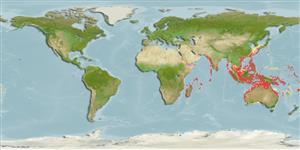Environment: milieu / climate zone / depth range / distribution range
Écologie
marin; saumâtre récifal; profondeur 10 - 80 m (Ref. 86942), usually 5 - 10 m (Ref. 127519). Tropical
Western Pacific.
Taille / Poids / Âge
Maturity: Lm ? range ? - ? cm
Max length : 22.0 cm TL mâle / non sexé; (Ref. 48636)
Rayons mous dorsaux (Total) : 39 - 41. Males recognized by long dorsal fin rays and large size (Ref. 48636). Under dorsal fin with 1 or 2 free pterygiophores (Ref 12934).
Found in steep sand slopes in large aggregations (Ref. 8631). Hovers above clean sandy bottoms; darts into the sand when disturbed. Usually slightly silty habitat. Usually seen resting on substrate, leaving substrate to grab prey from zooplankton floating over, or when displaying (Ref. 48636).
Life cycle and mating behavior
Maturité | Reproduction | Frai | Œufs | Fécondité | Larves
Randall, J.E., G.R. Allen and R.C. Steene, 1990. Fishes of the Great Barrier Reef and Coral Sea. University of Hawaii Press, Honolulu, Hawaii. 506 p. (Ref. 2334)
Statut dans la liste rouge de l'IUCN (Ref. 130435: Version 2024-2)
Menace pour l'homme
Harmless
Utilisations par l'homme
Pêcheries: commercial; Aquarium: Commercial
Outils
Articles particuliers
Télécharger en XML
Sources Internet
Estimates based on models
Preferred temperature (Ref.
123201): 24.6 - 29, mean 28 °C (based on 932 cells).
Phylogenetic diversity index (Ref.
82804): PD
50 = 0.5020 [Uniqueness, from 0.5 = low to 2.0 = high].
Bayesian length-weight: a=0.00389 (0.00180 - 0.00842), b=3.12 (2.94 - 3.30), in cm total length, based on all LWR estimates for this body shape (Ref.
93245).
Niveau trophique (Ref.
69278): 3.4 ±0.45 se; based on food items.
Fishing Vulnerability (Ref.
59153): Low vulnerability (12 of 100).
Nutrients (Ref.
124155): Calcium = 78.6 [42.2, 129.3] mg/100g; Iron = 0.722 [0.444, 1.207] mg/100g; Protein = 18.5 [17.4, 19.5] %; Omega3 = 0.103 [0.060, 0.187] g/100g; Selenium = 37.1 [17.9, 73.1] μg/100g; VitaminA = 125 [45, 367] μg/100g; Zinc = 1.78 [1.21, 2.50] mg/100g (wet weight);
